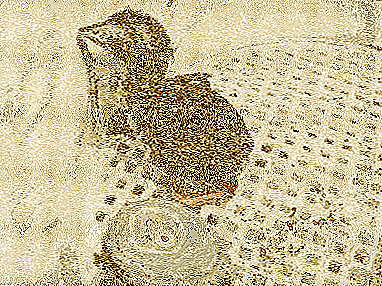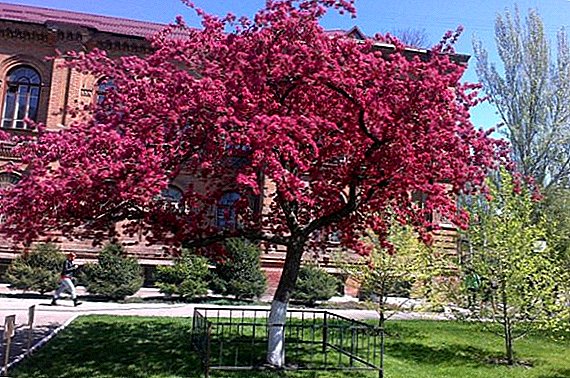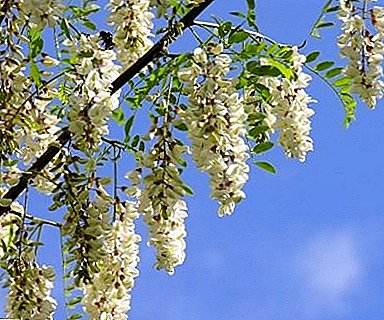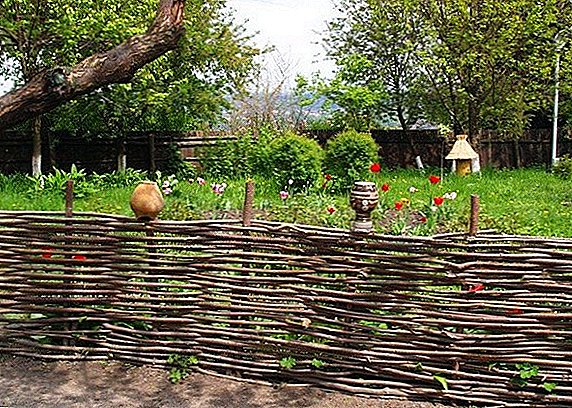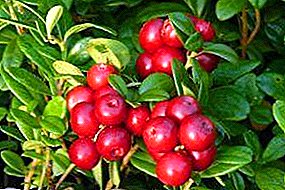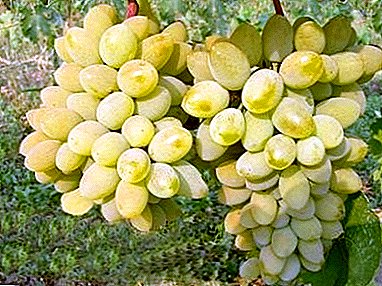
Grapes From time immemorial, it grew in the southern regions of our country.
However, the emergence of industrial viticulture is associated with the beginning of the 17th century - the period of laying the specialized gardens in the annexed territories from the Caspian Sea to the Sea of Azov.
There was an attempt to break the grape garden near Moscow, but every winter the saplings brought from Kiev and Chuguev had to be carefully covered with matting and spruce branches. This garden did not last long.
The article discusses the Timur grapes in detail, as well as a full description of the variety and photo of the fruit.
Breeding history
It is not by chance that the leading center for the selection of new hybrid forms of grapes is located in the historical zone of viticulture of Russia.
VNIIViV them. Potapenko has existed in Novocherkassk since 1936 and during this time he registered in the State Register more than 50 varieties of this crop, 21 - of its own selection. Among them, the fame are Harold, Red Delight, Pearl and Denisovsky.
The goal of the research institute - to promote grapes in the northern regions - is being successfully solved: Yekaterinburg and Vyatka have now become the cultivation boundary.
Another variety resistant to Russian winters has become “Timur”. And he got his name as recognition of unique qualities: invulnerability to frosts and putrefying diseases, because in translation from Turkic it means “Iron”.
The basis of the crossing process were taken two popular table varieties, characterized by extraordinary taste and agrotechnical characteristics:
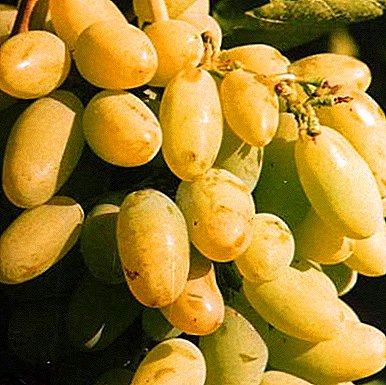 Moldavian grapes Muscat group "Frumoasa Albe" ("White Beauty"), which has a tasting score of 8.2 points.
Moldavian grapes Muscat group "Frumoasa Albe" ("White Beauty"), which has a tasting score of 8.2 points.The variety is unprecedentedly resistant to diseases and low temperatures. Consumer quality of heavy brushes and a significant regular yield - another motive for the selection of "Frumoas Albe" in the parent pair.
The same resistance to minus can boast except that the Beauty of the North, Super Extra and Arched.
- Table Grapes Delight - the success of Novocherkassk breeding proven over the years.
He slowly mastered the territory atypical for viticulture: Belarus, the Baltic States, Siberia, the Far East.
In terms of sugar accumulation and the severity of the hand, it surpasses the “White Beauty”, is well preserved on the bush after ripening and maintains its presentation for longer than the Moldovan variety.
The exceptional ability of parent plants to create perennial wood and excellent rooting is another plus perceived by the new hybrid form, called "Timur".
In the Middle Ages, monks used to grow vines indoors in monasteries. In the 18th century, grape orangeries built the breeder Demidov on the banks of the Moscow River. And before the creation of the All-Russian Institute of Scientific and Technical Investigations, they engaged in selection work only in Odessa.
Advantages and disadvantages
New hybrid inherited from eminent parents:
- ability to self-pollination (bisexual flower);
- universal compatibility with stocks;
- early dates of entry into the productive phase (for the 2nd year);
- early maturation (within 100 days);
- active fruiting;
- solid severity of the correct form of the brush;
- large, dense, oval-shaped berries with an exquisite nutmeg aroma;
- thin, easy to bite, skin;
- sugar content exceeding parental norms (25%);
- assessment of putrefaction in 2.2 points;
- frost resistance index within -25оС.
As for the high sugar content, Angelica, Krasa Nikopol and Lydia have the same sign.
Disadvantages grape varieties "Timur" include:
- undersized bush;
- rigor to the composition of the soil and feeding;
- needs rationing.
Amirkhan, Husayne Bely and Vityaz also possess bisexual flowers.
A photo
The Timur grape variety photo:





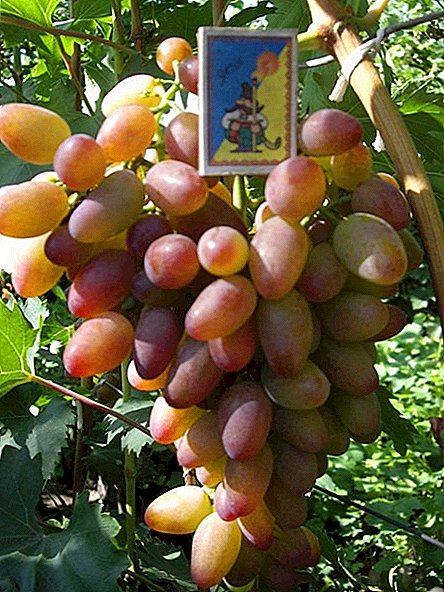
Description of the Timur grape variety
- The bush is powerful (up to 3 meters), with a large number of strong shoots taking a total load of 40 buds. Characterized by:
- reduced terms of readiness for fruiting;
- early end of the vegetative cycle (by mid-August);
- high efficiency of fruitful shoots (70%);
- resistance to fungal diseases, which corresponds to 2.2 points.
- The shoots are strong, capable of ripening 1-2 clusters; aimed at decorative support can be a decoration of landscape design.
- Flower hermaphroditic, assembled in a brush.
- The leaf is dark green, five-blade with deep cuts and teeth along the edge.
- The cluster is friable, cylindrical in shape, on a comb of medium size. Large brush mass (average 800 gr.)
- The elongated large berries are heterogeneous in color in the brush: I have the color of all shades of pink, even purple. The skin is thicker than that of the parent variety, but eaten. Sugar content is higher. Tastes are determined by 8.2 points.
- The hybrid is still under study, therefore frost resistance and vulnerability to fungal diseases are determined by parents as high.
- Transportability of fruits has an average level.
Pink color The berries are given by the substance present in the skins - anthocyanin. It helps our body fight inflammation, oxidative damage to blood vessels and even cancer cells.
Pink varieties include Pink Flamingo, Annie and Arcadia.
Grapes in the daily diet - the key to a healthy diet.
Dining varieties such as "Timur", extremely convenient for fresh consumption:
- the berry is large and juicy, without excess acid;
- the skin is delicate and easy to bite;
- grains are small and in small quantities (2-3).
Subspecies of grapes
White
Grapes "Timur" description of the variety. In general, as a plant variety is characterized by a small force of growth, frost resistance, early ripening and stable fruiting.
 Short stature bush determines the characteristics of the approach to planting it - away from tall fellows who can clog the plant, shading or braiding it with their shoots.
Short stature bush determines the characteristics of the approach to planting it - away from tall fellows who can clog the plant, shading or braiding it with their shoots.- Young shoots are quickly involved in the fruiting process and able to grow to full maturity up to 3 clusters (efficiency is 95%).
- Flower small, light green, with a female organ - pistil, and masculine - stamens, which are raised above the ovary.
- Sheet not very large, not very cut, wrinkled, without special differences of the reverse side.
- Bunches dense or moderately friable, elongated, with elongated berries of various sizes; bunch weight up to 600 g .; in the third year of life, when rationing, can reach 2 kg.
- Berries large (up to 8g.), white-green or yellow-green in the mature phase, with eaten peel and a palatable nutmeg taste; not prone to pea.
- Evaluation taste tasting scale - 8.5 points.
- On the strong-growing stock, the variety improves the presentation of fruits, but increases the ripening time.
- You need to be prepared that long pruning will reduce the yield of shoots.
- The quality of the soil can affect the taste of ripe berries.
- Well kept on the bush after ripening without loss of taste, but in transportation is not very stable (only for short distances).
The variety is well included in the design of the open elements of the house: they can braid a shed at the porch or gazebo. In this case, "Timur" will combine decoration and fruiting.
Pink
We're the same blood?
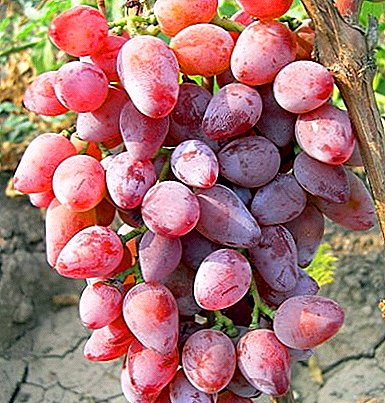 It is quite natural that such a promising hybrid form as "Timur", received a continuation in another selection experiment already "OV" Grape Elite "(Zaporozhye).
It is quite natural that such a promising hybrid form as "Timur", received a continuation in another selection experiment already "OV" Grape Elite "(Zaporozhye).
White table grape "Timur" made in the parent pair.
For the emergence of a new hybrid - "Timur pink" (selection code ZT-4-5), the “Red Delight” variety from the Kuban selection was also chosen, giving a new pattern a pink color.
Matching the main parameters with white "Timur" his pink descendant added markedly:
- in the growth of the bush (to medium and even large height)
- in the size of the brush (average weight 800 gr.);
- in the size and sweetness of berries;
- in the thickness of the skin of the berries, and hence increased transportability.
The daughter form did not reach the optimal maturity of the parent's early maturity (the earliest time is 110 days), and the quality brush "Timur pink" characterized by obvious friability. But the elongated berries turned out to be a delightfully deep pink tone, which makes them the decoration of the garden and festive table.
In the new hybrid form in the course of selection, an enemy appeared in the form of a spider mite. Therefore, choosing between the beauty of the berries and resistance to disease, gardeners prefer Timur to white.
Use
Rules for the effective use of table varieties:
 during the day, you can eat up to 1.5 kg of grapes (or 700 ml of juice), dividing this volume into 3 doses (before meals according to the scheme of three meals a day);
during the day, you can eat up to 1.5 kg of grapes (or 700 ml of juice), dividing this volume into 3 doses (before meals according to the scheme of three meals a day);- berries are eaten at least 40 minutes (maximum 1.5 hours) before meals;
- even though this berry is habitually perceived by us as a dessert, you should not eat grapes immediately after eating nourishing and fatty foods;
- grapes are not compatible with carbonated drinks and chocolate;
- given the calorie content of this fruit, it is quite possible to replace them, for example, dinner;
- there are grapes of table varieties needed with skin and stones, which are high in antioxidants and beneficial elements;
- after the delicacy, it is necessary to rinse the mouth, in order to avoid the effect of acid on the tooth enamel;
Grapes have many contraindications, so it can be eaten only by consulting a doctor.
Grapes treat a number of diseases, raise vitality, activate metabolic processes in the body. Treatment by grapes - in other words ampelotherapy - has become today the prestigious option of a sanatorium-resort complex in many countries.
Famous table varieties are Karmakod, Korinka and Alexander.
For a variety of table grapes can be made:
- fresh juice as an element of diet;
- compote of grapes (fresh or pasteurized, from some grapes - with the addition of other fruits);
- fillet - boiled and filtered juice with spices and crushed walnuts;
- marinated grapes as an exquisite component of meat dishes or a kind of snack;
- jelly (without adding gelatin) from grape juice cooked according to a special recipe;
- syrup from highly sugary grape varieties;
- grape jam;
- churchkhelu — an oriental sweetness familiar to all;
- low-alcoholic liquor - a product of fermentation of grapes in sugar syrup;
- and a number of recipes for processing characteristic of the regions of growing grapes.
Care
- Inoculation on old stocks is better to do in spring.
- For rootstocks optimally choose strong-growing plants.
- From the planted seedlings should not expect in the near future abundant harvest.
- The best place for this grape variety is under the house wall from the south or south-west side.
- "Timur" prefers light and warm soils, well fertilized with organic matter, with a sufficient content of potassium and nitrogen (without an overabundance).
- With regular watering in the first half of the growing season, from the time the berries ripen, stop watering (except for drought).
- Despite the stated resistance to frost, the variety needs shelter for the winter, especially in the northern regions.
Love the work of your hands - and grapes "Timur" will respond with a bountiful harvest of sweet berries.


 Moldavian grapes Muscat group "Frumoasa Albe" ("White Beauty"), which has a tasting score of 8.2 points.
Moldavian grapes Muscat group "Frumoasa Albe" ("White Beauty"), which has a tasting score of 8.2 points. Short stature bush determines the characteristics of the approach to planting it - away from tall fellows who can clog the plant, shading or braiding it with their shoots.
Short stature bush determines the characteristics of the approach to planting it - away from tall fellows who can clog the plant, shading or braiding it with their shoots. during the day, you can eat up to 1.5 kg of grapes (or 700 ml of juice), dividing this volume into 3 doses (before meals according to the scheme of three meals a day);
during the day, you can eat up to 1.5 kg of grapes (or 700 ml of juice), dividing this volume into 3 doses (before meals according to the scheme of three meals a day);